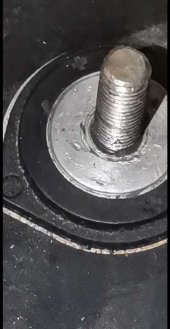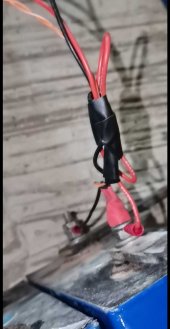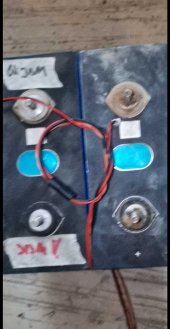The theory the one cell developed an internal short and caused the meltdown and fire just doesn't seem plausible to me.
To my knowledge we don't have any examples of this happening before.
We have seen a lot of examples of a connection getting VERY hot if there is a loose connection or corrosion causing a bad connection ..... I think that it is the most likely explanation of what caused that cell to melt down.
@Bob B ,
2 things to mention.
First one.
Apparently I'm (almost) the only one who have bloated cells, and continued to use them.
This is a whole different ballpark.
What happens when you slightly compress bloated cells to prevent them from further expansion?
I can tell you, they de-bloat.
Slight compression is enough.
When tight enough not to be able to lift a cell out in a row of 6, a week later you can lift it out.
My mistake. (I guess) is to think "hey great, let's tighten a little more" same, just enough to not be able to lift a cell out of the 6.
After a few weeks the bloating was half.
For capacity, I've tested them all.
Between 144-151Ah after a year of usage.
Not so bad, consider they are bloated.
Was it a mistake?
I don't know. If it was, it's an understandable, without having deep knowledge of LiFePO4, reason for bloating, etc.
Where sure, we can all think of a few, over charge, over discharge, too high current in or out, short.
If none of this was the situation, just too many sheets in a housing...
You tell me. I don't know.
Just sharing what I did.
I wonder why people see 12v setup.
It's 48v S16, 5 sets in series.
So S16, 5*
The part that was installed, connected with Bus-bars was 1 X 280 S16 and 1 X 152Ah S16.
This was like this for many weeks, with regular checks for temperature.
Almost every day.
Due my last accident, I did not want to leave anything to chance.
At the moment of the fire, the cells where balanced, at +48v, between 2.9 and 3v
No crazy discharge.
Charge capacity was a few ampere, 3-400 watt on the 2 sets.
Like an airbag doesn't protect when there is no accident, BMS in this setup would not have done anything.
There was no trigger to act.
DIYBMS finished setup with smoke detector, that one would have triggered.
Finished DIYBMS with temperature sensor on EACH cell, that one would have triggered.
Standard Daly??
Only in the situation if the temperature sensor would have been at the cell that failed.
BMS stops charge or discharge at under/over charge and over capacity.
This was not happening!!
3-4A charge, 10-20% SOC.
Absolutely no reason to act.
I understand why people like to point a blame to my installation.
If I didn't do anything wrong...
It would make them feel unsafe about their own installation!
And you should.
Like the fire from Tesla showed...
It's never safe.
I'm absolutely certain that the wires where not the reason for the fire.
I'm even thinking about filming a full short with a wire for you guys to show how (not) spectacular that is.
Self fusing at 10A...
Like watching grass grow, that exiting.
Please let me know if you guys want this
So...
If it was
- not the wires..
- not the SOC (10-20%)
- not lack of BMS
- no lose contact or enough charge/discharge that would have made enough heat..
Possible options are greatly reduced.
Compression of bloated cells is apparently not a good idea ?
If you have them, leave them bloated, allow them to bloat even further if they want.
It doesn't hurt the capacity much, and compression can/ will create stress that can/will give a fire.
If you are a bit handy in making threads, buy cells without holes.
Use a forming tap, what makes way stronger threads.
Your end product will have a safer start then it would have been pre-drilled and tapped from China.
Grubscrews +Loctite red and primer
Before you even begin to do anything.
If sheets between cells can prevent accidents, use them.
I doubt Eve is placing them in their pre-build packs without reason.
Torque meter (!) As Equal torque will give more equal charge.
Less risks.
@Will Prowse
"Up in smoke" has also my vote
Alternative:
Magic smoke corner.
















